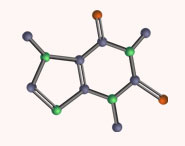


 علم الكيمياء
علم الكيمياء 
 الكيمياء التحليلية
الكيمياء التحليلية 
 الكيمياء الحياتية
الكيمياء الحياتية 
 الكيمياء العضوية
الكيمياء العضوية 
 الكيمياء الفيزيائية
الكيمياء الفيزيائية
 الكيمياء اللاعضوية
الكيمياء اللاعضوية 
 مواضيع اخرى في الكيمياء
مواضيع اخرى في الكيمياء
 الكيمياء الصناعية
الكيمياء الصناعية |
أقرأ أيضاً
التاريخ: 27-12-2016
التاريخ: 10-5-2019
التاريخ: 31-5-2017
التاريخ: 2023-07-23
|
In the reaction of ammonia with borane, not only do the molecules have to collide with enough energy to react, but they must also collide with the orbitals aligned correctly for them to interact. As you saw in Chapter 3, the lone pair of the nitrogen atom resides in a filled, nonbonding sp3 orbital. This orbital has to overlap with the empty p orbital on B to form a bond. So, a collision like this
will do just fi ne for making a bond, but collisions like these
will not do at all. Of course, we can also draw a molecular orbital energy level diagram for the constructive, end-on interaction of the orbitals: look back to Chapter 4 to remind yourself of how to do this. Here, we need the fi lled sp3 orbital on N to interact with the empty p orbital on B to give a new σ bonding orbital and an empty σ* antibonding orbital. Finally, putting in the two electrons from the N’s lone pair gives us a full picture of the new B–N bond.
The energy level diagram makes it clear why bonding is favorable too: the electrons have dropped down from the non-bonding sp3 orbital to the new lower energy bonding σ orbital. We don’t need to consider what has happened to the energy of the unfilled orbitals because they’re empty and don’t contribute to the energy of the molecule as a whole. We can generalize this idea to work out what makes a good nucleophile and a good electro phile. We’ll use an imaginary, generic nucleophile Nu, with a pair of electrons in some sort of fi lled orbital (it doesn’t matter what this orbital is) which it can donate to the empty orbital of a generic electrophile E. Here are three versions of the molecular orbital energy level diagram:
On the left, the energies of the fi lled Nu orbital and the empty E orbital are almost the same. There is a significant gain in energy when the new bond forms between them. On the right, there is a large difference between the energies of the fi lled Nu orbital and the empty E orbital, and the energy gain is negligible. This tells us something: the best reactions are ones in which the energies of the interacting orbitals are similar in energy.
● For a reaction to take place, molecules must:
• approach each other such that these orbitals can overlap to form a bonding interaction.
• have orbitals of appropriate energy to interact—a fi lled orbital on the nucleophile and an empty orbital on the electrophile
• overcome their electronic repulsion by charge attraction and/or orbital overlap



|
|
|
|
حقن الذهب في العين.. تقنية جديدة للحفاظ على البصر ؟!
|
|
|
|
|
|
|
"عراب الذكاء الاصطناعي" يثير القلق برؤيته حول سيطرة التكنولوجيا على البشرية ؟
|
|
|
|
|
|
|
مشاتل الكفيل تنتج أنواعًا مختلفة من النباتات المحلية والمستوردة وتواصل دعمها للمجتمع
|
|
|